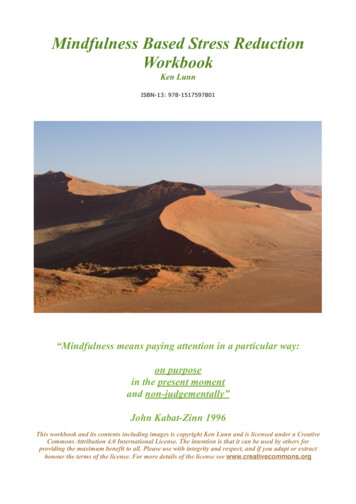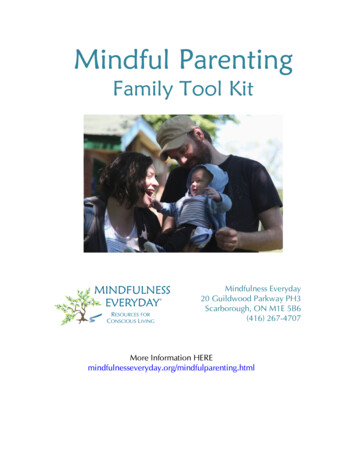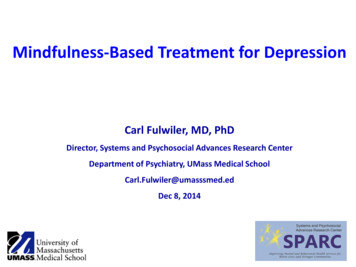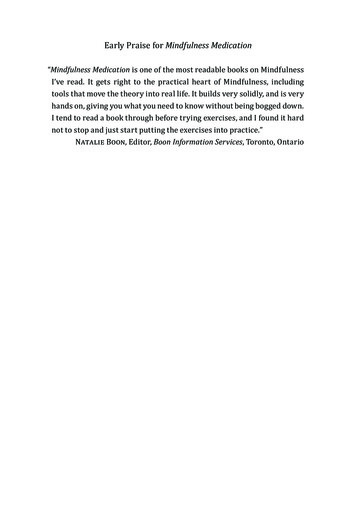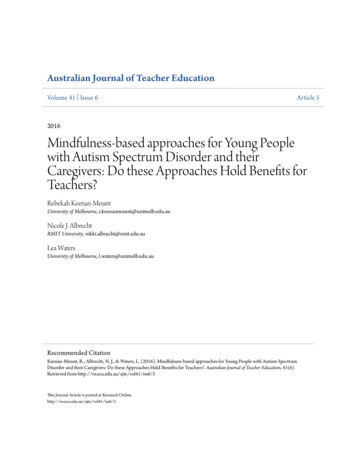
Transcription
Australian Journal of Teacher EducationVolume 41 Issue 6Article 52016Mindfulness-based approaches for Young Peoplewith Autism Spectrum Disorder and theirCaregivers: Do these Approaches Hold Benefits forTeachers?Rebekah Keenan-MountUniversity of Melbourne, r.keenanmount@unimelb.edu.auNicole J. AlbrechtRMIT University, nikki.albrecht@rmit.edu.auLea WatersUniversity of Melbourne, l.waters@unimelb.edu.auRecommended CitationKeenan-Mount, R., Albrecht, N. J., & Waters, L. (2016). Mindfulness-based approaches for Young People with Autism SpectrumDisorder and their Caregivers: Do these Approaches Hold Benefits for Teachers?. Australian Journal of Teacher Education, 41(6).Retrieved from http://ro.ecu.edu.au/ajte/vol41/iss6/5This Journal Article is posted at Research Online.http://ro.ecu.edu.au/ajte/vol41/iss6/5
Australian Journal of Teacher EducationMindfulness-Based Approaches For Young People With Autism SpectrumDisorder And Their Caregivers: Do These Approaches Hold Benefits ForTeachers?Rebekah Keenan MountUniversity of MelbourneNicole Jacqueline AlbrechtRMIT UniversityFlinders UniversityLea WatersUniversity of MelbourneAbstract: Parents and teachers who care for and educate youngpeople with Autism Spectrum Disorder (ASD) face unique challengesassociated with their roles. In this review we investigated the efficacyof mindfulness-based interventions in reducing stress and increasingpositive behaviours in young people with ASD and their caregivers:parents and teachers. Nine studies on the topic were located,showing that the research base in this field is in the infancy stage.Each study illuminated the transformational change caregivers andyoung people experience after practicing mindfulness training (MT).The results also highlighted the interdependent relationship betweenthe caregivers’ level of mindfulness and their child’s pro-socialbehaviours. We recommend that future researchers focus onunderstanding mindfulness as a relational practice as well as howthe practice can support teachers who care for and educate studentswith ASD.Keywords: Mindfulness, meditation, Autism Spectrum Disorder, interventionsIntroductionAutism Spectrum Disorder (ASD) is a life-long neurological disorder. It ischaracterised and diagnosed by differences in social communication and atypical patterns ofbehaviour. Children with ASD might play alone and withdraw from social situations; havedifficulty understanding other people’s perspectives or feelings; have particular interests orattachments; and prefer routine and structure that might be considered restricted andrepetitive to others (autismpecturm.org.au). These atypical patterns of behaviour can result inchildren with ASD feeling frustrated easily, resulting in challenging behaviours such astemper tantrums (Bluth, Roberson, Billen, & Sams, 2013). The expression of thesecharacteristics occurs on a spectrum, meaning there is a wide degree of variation in how itaffects individuals as well as the severity of symptoms (Bluth et al., 2013). For example,where one child with ASD may be highly verbal, he or she may not socialise well withothers. Likewise, where one child with ASD might be overly disturbed by sensory stimuli,another child with ASD would underreact. According to the Australia Bureau of StatisticsVol 41, 6, June 201668
Australian Journal of Teacher Education(ABS), approximately one in 100 people in Australia have ASD, males being four times morelikely to be diagnosed with ASD than females (ABS, 2012).Parents and teachers of young people with ASD experience unique challenges incaregiving (Benn, Roeser, Arel, & Akiva, 2012). Stress and anxiety associated with theirroles has been shown to “impact upon parents’ and special educators’ health and well-being,as well as the quality of their parenting and teaching” (Benn et al., 2012, p. 1476). Thecomplexity of ASD symptoms can hinder and frustrate the development of sibling andparent-child relationships at home and peer and teacher-child relationships in school settings(Sequeira & Ahmed, 2012, p. 2). Often, young people with ASD have difficulty withcognitive processing (Cachia, Anderson, & Moore, 2015) and can feel overwhelmed whenconfronted with confusing situations (Russell, 2011). As a result, they may become frustratedeasily and respond with angry outbursts or with physical aggression (Singh et al., 2011). Fora parent, this can mean that going from one activity to another triggers an emotionalmeltdown in their child with ASD; this can be distressing and stressful (Russell, 2011). For ateacher, school excursions, recess or other occasions where routines are disrupted may causedistress in a student with ASD. A recent Canadian study, investigating the challengesteachers encountered providing for children with ASD in mainstream classrooms, found thatteachers lacked adequate strategies to appropriately manage a student with ASD when abehavioural outburst occurs (Lindsay, Proulx, Thomson, & Scott, 2013). One teacherparticipant interviewed reported: “There are days where you might have a student withautism who has a meltdown and you can’t deal with it right then and there You just can’talways work with just one child” (Lindsay et al., 2013, p. 355).In addition to these challenging behaviours, basic behaviours that mediate socialinteractions such as eye contact, facial expressions and gestures are not easily “read” byyoung people with ASD. For teachers, this may make establishing rapport with a studentwith ASD challenging as well as including them as a full participant in classroom lessons andamongst their peers (Lindsay et al., 2013). While the emotional impact of ASD on families isacknowledged, research into the various impacts for teachers who work to provideappropriate educational opportunities and meet the specific needs of students with ASD hasreceived scant attention. In this paper, we provide a review of studies involving mindfulnessbased interventions as an approach to enhancing the emotional wellbeing of young peoplewith ASD, their parents and their teachers.Early research suggests that mindfulness-based programs have the potential to supportyoung people with ASD as well as the adults who care for them (Singh et al., 2011).Cultivating mindful qualities, such as emotional awareness, non-judgemental acceptance,equanimity, and compassion (including self-compassion) (Albrecht, 2015; Shapiro &Carlson, 2009) may prove promising in improving executive functioning and reducingaggressive and problem behaviour in young people with ASD. A study by Singh et al. (2011)suggests that adolescents with ASD can successfully and effectively learn to use mindfulnesspractices to self-regulate stress responses and enhance their wellbeing. Similarly, mindfulnessinterventions with parents can reduce stress and anxiety and enhance parent-child interactions(de Bruin, Blom, Smit, van Steensel, & Bögels, 2014; Hwang, Kearney, Klieve, Lang, &Roberts, 2015; Singh et al., 2007). Currently, only one study by Benn et al. (2012) consideredthe efficacy of mindfulness as a tool for teachers who work with students with ASD. Despitethis gap, it is not difficult to envision how the components of mindfulness emotionalawareness, self-regulation and non-judgemental acceptance – including compassion (of thechild and the caregiver-self) can benefit teachers who work with young people with ASD.In this review, the following research questions are addressed:1.What is the efficacy of current mindfulness-based interventions for young people withASD and their parents?Vol 41, 6, June 201669
Australian Journal of Teacher Education2.What are the characteristics of the various mindfulness-based interventions? How isthe intervention structured, and what are the expectations of the participants involved?3.What are the measures used?4.What interdependent effects are evident as a result of mindfulness training?5.How might a mindfulness practice benefit teachers who work with students withASD?Finally, suggestions are made to stimulate future research in the field of ASD andeducation.Mindfulness DefinedMindfulness practices are generally inspired by principles and practices, commonlyassociated with Buddhist and other spiritual traditions including Hinduism, Islam, Taoismand Judaism (Albrecht, Albrecht, & Cohen, 2012; Stahl & Goldstein, 2010). In academicliterature, mindfulness is often used interchangeably in three main ways (Albrecht et al.,2012). First, it is used to describe a state of mind, second, a trait or disposition and lastly, as apractice or method for cultivating either a mindfulness state or more lasting trait (Grossman,2008). Kabat-Zinn (Kabat-Zinn, 1990, 2003, 2005) founder of one of the most popular andresearched program, Mindfulness-based Stress Reduction (MBSR), conceptualisesmindfulness as a state where awareness emerges through paying attention on purpose to thepresent moment, not with judgment, but with curiosity and acceptance. MBSR is a programaimed at cultivating a mindful state (Albrecht, 2015). Of course, like other mental states, suchas excitement and fear, mindful states are momentary. Other mindfulness researchersconceive of mindfulness as a trait or disposition, that is, they propose that humans have theinherent capacity to be mindful, and some people are naturally more mindful than others(Albrecht et al., 2012; Shapiro, Carlson, Astin, & Freedman, 2006; Wallace, 2006). Lastly,the term mindfulness is also used in the literature to describe two broad methods or practicesthat cultivate mindfulness. The first involves the withdrawing from daily activity tointentionally engage with formal meditation techniques. The second involves purposefullyintegrating what is learned in the formal practice into daily activity, such as washing thedishes, eating or brushing your teeth with mindful attention. Mindfulness-based programs,such as MBSR, explicitly teach both formal and informal mindfulness practices. Where theliterature is in agreement is the idea that a dedicated and regular mindfulness practice willdevelop a person’s capacity to go beyond fleeting states of mindfulness to experiencing moreenduring traits of mindfulness (Anderson, Levinson, Barker, & Kiewra, 1999, p. 8; Wallace,2006, p. 4).Mindfulness ProgramsOver the last three decades an array of mindfulness-based programs, offering amyriad of applications from smoking cessation to enhancing creativity have been developedfor schools, workplaces, hospitals and prison systems (Albrecht, 2015). The antecedents andpractices of a large number of the programs for both adults and children can be traced back tothe MBSR course (Broderick, 2013; Rechtschaffen, 2014). The course was founded byKabat-Zinn and colleagues in the late 1970s at the University of Massachusetts Hospital(USA) and was initially called the “Stress Reduction and Relaxation” program (Kabat-Zinn,1982).Vol 41, 6, June 201670
Australian Journal of Teacher EducationThe rationale for the program’s establishment was to “catch patients who tend to fallthrough the cracks in the health care delivery system” (Kabat-Zinn, 1982, p.33). KabatZinn’s (1982) aim was to assist individuals suffering from chronic pain; those who wereeither dissatisfied with bio-medical health care or could no longer be helped by the Westernpractices of medicine. The course’s primary objective was to develop the internal resourcesof the client through a spectrum of 1) meditation techniques; such as yoga postures (asana),mindfulness meditation and 2) education in regards to the physiology of stress, consequencesof disregarding the stress response and understanding the mechanisms involved with therelaxation response, pioneered by Herbert Benson (see http://www.relaxationresponse.org/)from the Harvard Medical School in 1975. The program was initially 10-weeks in durationwith clients attending a two-hour session once a week. The following meditation practiceswere taught: body scan; mindfulness of breath and other sense perceptions; Hatha Yoga;mindful walking; mindful standing and mindful eating. Didactic material includedinformation on the relationship of stress to physical ailments, consequences of the flight orflight response and how to balance autonomic arousal (Albrecht, 2015).An escalating body of empirical research attests to the success MBSR and othermindfulness programs in assisting both clinical and non-clinical adult populations topositively manage various forms of physical (e.g. pain) and psychological (e.g. perceivedstress and anxiety) suffering and, in turn, enhance wellbeing. Further, recently publishedstudies of mindfulness-based programs for children and adolescents suggest similar benefitsstem from these populations (Meiklejohn et al., 2012). School-based mindfulness programshave been shown to improve outcomes for students in relation to their cognitive functioning,academic achievement, emotional regulation, social competence and wellbeing (Waters,Barsky, Ridd, & Allen, 2014). There are now at least 30 different mindfulness programs inschools (Albrecht, 2015). Recent statistics from the United Kingdom (UK) indicate thatnearly 50% of school-age children engage in some form of mindfulness activities (Stone,2014), with Australia following the UK’s trend (Albrecht, 2015).Notably, in relation to the aims of the current paper, two systematic reviews of 10mindfulness curricula designed for youths (Meiklejohn et al., 2012) and 15 meditationprograms in schools (Waters et al., 2014) did not include any programs or research involvingASD populations.Literature ReviewA systematic literature search was conducted during July 2015 and August 2015,using the key search terms: ASD [autism] AND mindfulness [mindful* and intervention* orprogram* or training]. The following databases were searched:British Humanities Index (BHI), ERIC, Google Scholar,Linguistics and Language Behavior Abstracts (LLBA), Philosopher's Index, ProQuestEducation Journals, ProQuest Education Journals, ProQuest Family Health, ProQuest Nursing & Allied Health Source, ProQuest Psychology Journals, ProQuest Religion. The journal,Mindfulness was additionally searched for relevant articles. The search was confined to theEnglish language with no year of publication restrictions.Only studies that involved mindfulness-based interventions were included for review.Studies focusing on multi-component programs such as Cognitive Based Therapy (CBT),where mindfulness meditation forms a small but not significant part of the curriculum wereexcluded. However, studies that included mindfulness and some form of psycho-educationtraining (e.g. Mindfulness-Based Psych-educational Program and Mindfulness Based PositiveBehaviour Support) were included. Intervention studies that involved adult participants orVol 41, 6, June 201671
Australian Journal of Teacher Educationpre-school children with ASD were also excluded, given our interest in teachers’ workingwith school-aged students with ASD.The search strategy resulted in nine peer-reviewed studies that met the criteria forinclusion. These studies included five that involved participants parenting young people withASD; two involved parents as well as their children with ASD (that is, parent-child dyads);one study was conducted with three adolescents with ASD. Only one study included teacherparticipants in addition to parent participants, highlighting an area for future research. Eachstudy involved a mindfulness curriculum, though this varied. Experienced mindfulnesstrainers with up to 40 years personal meditation practice facilitated most of the interventions.All studies required their participants to learn to meditate and included establishing a regularhome meditation practice. Key details of each study are presented in Table 1.Vol 41, 6, June 201672
Australian Journal of Teacher EducationTable 1 Mindfulness interventions for Young People with Autism Spectrum Disorder and their CaregiversAuthor andyearBenn et al.,2012de Bruin etal.,2014Ferraioli &Harris, 2013Mindfulness-based ntUSApre-post, 2 monthf/upNetherlandspre-post, 9 monthf/upPilot studyUSARandom ControlTrail (RCT)pre-post, 3 monthf/upVol 41, 6, June 201632 parents(2 M, 23 F)38 teachers(3 M, 32 F)Total n 70SMART-in-Education(Stress Management andRelaxation Techniques)23 adol. (aged11-23 years)with ASD (17 M, 6 F) 29parents(11 M, 18 F)Total n 52MyMind: Mindfulnesstraining for adolescentswith ASD (MyMind)and parallelMindfulness Parentingtraining15parents ofchildren withASD (5 M, 10 F)Total n 15Participants randomisedinto either theMindfulness BasedParent Training (MBPT)grouporSkills Based ParentTraining (SBPT) groupDuration5 week intensive4 x half-days per week36 hours in total9-weeks1.5 hour weeklysessions, "jointbooster" at 9 week f/upwhere parents andchildren meditatedtogether8 sessions,2 hrs weeklyDataFindingsFacilitator2 x pairs of experiencedmindfulness trainers (inMBSR and SMART)2 x mental health careprofessionals with ASDexperience training inMBSR and MyMind.2 doctorial studentssupervised by a clinicalpsychologist73YesWaitlistedNoYesSelf reports:mindfulness, stress,anxiety, depression,positive and negativeeffect, personal growth,self compassion,forgiveness, empatheticconcern, teaching selfefficacy/parenting selfefficacy emotionregulation self-efficacy,quality of parent-childinteraction.Self reports: Adol.:mindful awareness,quality of life,rumination,worrying, andASD symptoms. Effectson ASD core symptoms social responsivenessreported by their parents.Parents: quality of life,parenting styles,parenting stresscompetence, mindfulawareness, andmindfulness inparenting.Self reports:parenting stress,general health,mindfulness, andapplied behaviour.1.2.Qualitative info reparticipants reactions totreatment3.3.4.1.2.3.4.5.1.2.4.Sig. reductions in stress and anxietyIncreased mindfulness, self-compassion andgrowthIncreased relational competenceSig. increases with relational competence inrelation to teaching specificallyAdol.: increase in quality of life anddecrease in rumination for at post-test andf/upNo changes in ASD core symptoms;worrying or mindfulness (rated by adol. andparents)Parents positive changes in adolescents'general social responsiveness at f/upParents improved competence in parenting,e.g. less lax, less reactive, less verboseparenting styleParents increase quality of lifeSig. decrease in parenting stress andimproved general health in the mindfulnessgroup at pre and post test (but not skillsgroup)Further decreases in stress for mindfulnessgroup at f/up.No sig. differences on either outcomemeasures observed for the skills groupIncreases for both groups on interventionspecific skills
Australian Journal of Teacher EducationAuthor andyearHwang et al.2015Mindfulness-based hodspilot studymother-childdyadschildren 5 M,1 F aged 8-15Total n 6Lilly &Tungol 2015Robledillo etal.,2015Singh et al.,2006ControlContentIndiaRCTpre-postSpainMixed designPilot studyUSAMultiple baselinedesignVol 41, 6, June 2016Stage 1: MindfulnessTraining (MT) for themothersStage 2: Parentmediated mindfulnessfor children with ASD,home-basedParents withchildren withASD (F 40)Total n 40Mindfulness-BasedPsych-educationalProgram (MBPEP)parents6 parents (1 M,5 F) with ofadol. with ASD 7 parents (7 F)of typicallydevelopingadolescents(age-matched)Total n 13Mindfulness BasedProgramParents of adol.With ASD(3 F)Total n 3Mindfulness TrainingDurationStage 1:8 sessions,2.5 hr weekly sessions( 2 month selfpractice)Stage 2:5 basic mindfulnessactivities over 12months10 sessionsrun weeklyDataFindingsFacilitatorStage 1: 2nd author with20 years MT experienceNoStage 2: parents-childwith initial support via 3weekly home visitsfrom the 2 authors online discussion social media over 12monthsNot statedYesResearcher interviewswith children (beforeS2), video recording ofmindfulness sessions (S1and S2), self reports:mindfulness, parentalstress, quality of life, andparents’ perceptions ofchild problembehaviours in familycontexts.1.2.Self-report: parentalstress1.2.3.4.3.9 sessions2 hrs, fortnightly1 x psychotherapisttrained in MBSRYesSelf reports: state-traitanxiety, mood, angerexpression, generalhealth.1.2.3.Salivary cortisolmeasurements (Csal) atweek 1, 5 and 9 ofintervention to measurestress.12 sessions,2 hours weekly 52weeks of personalpractice1 on 1 training withsenior investigator74NoObservational data ontarget behaviours(aggression,noncompliance, and selfinjury) collected bymothers using a PDA.Inter-rater agreements(fathers).Parent self-reports:parenting satisfaction,interaction satisfaction,mindfulness.1.2.3.4.Out of 6 mother-child dyads, 5 completed S2Reduction in parenting stress and increasedmindfulness at S1Concomitant change in child’s behaviourafter S1 but before S2Increase in quality of family life at S1 andfurther increase at the S2Sig. decrease in parental stress (exp. group)Positive changes in attitudes toward theirparenting a child with ASD (exp. group)No change in parental stress (control group)Positive effects on health across participantsReduced anxiety, negative mood, andreduced Csal levels across participantsReduced Csal more pronounced in parents ofadol. with ASD then parents of typicallydeveloping adol.Sig. decreases in target behaviours(aggression, noncompliance, and self-injury)Increases in mindful parentingIncreases in parent satisfaction with theirparenting skillsIncreased positive interactions with theiradol. with ASD
Australian Journal of Teacher EducationAuthor andyearSingh et al.,2011Singh et al.,2014Mindfulness-based InterventionCountry/DesignUSASingle caseexperiment design, 3yr f/upUSAMultiple baselinedesign qualitativeinterviewsVol 41, 6, June 2016Participantsadol. with ASD(3 M) 14-16yrsTotal n 3Parents of adol.With ASD(3 F)Total n 3ControlContentDurationMeditation on the Solesof the Feet (SoF)Meditation on the Solesof the Feet (SoF)5 x days 30mins training practice twice dailywith mothersParent-mediated8 sessions,3 hours weekly (1-to-1format) 52 weeks ofpersonal practiceFacilitator with 40-yearpersonal meditationpractice with clinicalexpertiseMindfulness BasedPositive BehaviourSupport (MBPBS)DataFindingsFacilitator75NoNoSiblings and parentsprovided data onoccurrences of physicalaggression (hitting,kicking and biting asibling or parent) withinter-rater agreement.1.Observational data onchallenging andcompliance behavioursof adol. with ASDcollected by mothersusing an iPhone App.Inter-rater-agreements(fathers).Self-report: parentalstress.Informal interviews withmothers.1.2.3.2.Continual decreases in aggressive incidentsacross the 3 adolescents at pre and post testMinimal incidents of aggression reported at3-yr f/up.Concomitant change in mother’s behaviour(not measured)Statistically sig. reductions in mothers' stresslevels were correlated with positivebehaviour changes in adol.Interviews indicated MBPBS was wellreceived; mothers felt it made a difference totheir lives in terms of their own personaltransformation and in their interactions withtheir children.
Australian Journal of Teacher EducationResearch into Mindfulness with Young People with ASD and their ParentsWhile the research base investigating the feasibility of mindfulness-based programs foryoung people is continually growing, only eight studies in total were found. Four studies werelocated that involved children with ASD, one study involved children with ASD only and threestudies involved parent-child dyads. In the following section, we review the eight studies.Mindfulness for Young People with ASDMindfulness-based programs for adults are largely modelled on the established MBSRprogram (Kabat-Zinn, 1982) or mindfulness-based cognitive therapy (MBCT; Teasdale et al.,2000). However, children, particularly those with ASD, may find sitting still or lying downpractices difficult. Instead, rather than a specific program, particular mindfulness techniquessuch as deep breathing (Russell, 2011) mindful movement (Etty-Leal, 2010) or mantra, mayprove more beneficial (Sequeira & Ahmed, 2012). A simple mindfulness-based technique formanaging angst, anger and aggression in young people is Meditation on the Soles of the Feet(SoF) developed by Singh and colleagues in the late 1990s. This applied meditation practiceteaches the child to direct his or her attention and awareness to a neutral body part, i.e., thesoles of the feet, as a way to defuse emotionally disturbing thoughts. By calming and clearingthe mind, the potential for an angry or aggressive outburst dissipates. SoF can be done whilestanding, sitting, or walking slowly and once learned and practiced, it can be a way to self-calmquickly when emotionally arousing situations occur. Research into SoF has shown its efficacyin controlling anger and aggressive behaviours in young people with Attention DeficitHyperactivity Disorder (ADHD) and ASD (Singh et al., 2011; Singh, Nirbhay, Lancioni,Winton, & Fisher, 2006; Singh, Nirbhay., Lancioni, Winton, Karazsia, & Singh, 2013; Singh etal., 2007; Singh et al., 2014).Singh et al. (2011) studied the effects of a mindfulness-based technique (SoF) to controlaggressive behaviour in three male adolescents with ASD. The participants in the study hadexperienced behavior modification interventions and/or psychopharmological treatments in thepast with no significant long-term effect. As such, each participant’s respective families feltexasperated by their son’s frequent outbursts of kicking, biting and hitting a sibling or parent.In this study, the mothers of each participant taught their sons the SoF mindfulness practiceover five consecutive days. During these 30-minute sessions, the adolescents sat comfortably ina chair, spine upright, hands resting gently on their thighs and feet flat on the ground. In thisformal meditation posture, participants learned to become aware of the present moment, usingthe breath as an anchor. With their mothers’ voices guiding them, the adolescents learned tobecome aware of any negative mind states that would precede an aggressive outburst and shifttheir attention to the soles of their feet - a neutral object. The participants continued to practicethe SoF technique on their own using a recording on their iPods. They did this at least twice aday with their mother and whenever an emotionally charged incident occurred that could elicitaggressive behaviour.Results showed that during baseline, the three participants were exhibiting an averageof 14, 20 and 16 acts of aggression per week (respectively). During mindfulness training,aggressive incidents decreased to an average of 6.3, 4.1 and 4.7. Significantly, in the follow upperiod of three years after the training only 4, 3 and 3 acts of aggression respectively occurredover that entire time period. These findings indicate a strong link between the mindfulnesstraining and the reduction in incidences of aggression towards family members in adolescentswith ASD. Additionally, the authors noted that the mothers also reported changes in their ownbehaviours, using the SoF technique as a tool to calm themselves when they felt stressed. ThisVol 41, 6, June 201676
Australian Journal of Teacher Educationchange in the mothers’ behaviour may have impacted upon the study results; however, thisinterdependent aspect of mindfulness practice was not accounted for in the study’s design.Mindfulness for Parent-Child DyadsTwo studies located for this review comprised both parents and their children with ASDas participants. Hwang et al.’s (2015) study included the six mother-child dyads. The intentionof the study was to train the mothers to become the mindfulness teacher with their own childwith ASD. In de Bruin et al. (2014), 23 adolescents and their parents participated in a 9-weekparallel parent-child mindfulness-based intervention.Hwang et al.’s (2015) pilot study consisted of a two-part mindfulness-basedintervention. Stage 1 (S1) involved an eight-week Mindfulness Training (MT) with the sixmothers. The MT program emphasized the core practice of formal meditation and a theoreticalgrounding in Buddhist teachings. The mothers were then required to immerse themselves in atwo-month self-practice period before commencing Stage 2 (S2). During S2, the mothers tookon the role of the meditation teacher for their children with ASD. S2 did not follow a formalstructure. The authors, who interviewed the children prior to S2, emphasized that it wasimportant to differentiate the learning content to adequately meet the individual children’sneeds. Besides five basic meditation exercises where children learned various practices toground their attention using the breath, bodily movement and sound, S2 was highlyindividualized. The basic meditation practices were filmed onto an iPhone application andchildren named the practices themselves promoting ownership (e.g. Lion Lying, Cat Walking).The “parent teachers” and children were encouraged to practice together as frequently aspossible over a 12-month period in order to make mindfulness apart of their everyday lives.Results of the two-stage intervention are largely positive. The direct effects of themindfulness training for mothers included reductions in perceived stress and increasedmindfulness. Qualitative data from group discussions and reflective diaries indicated positivechanges to the participants’ personal and family lives during the training phase. The mothersalso reported positive changes in their child’s behaviour after S1 but before their childcommenced S2, supporting the notion that mindfulness reveals itself relationally.de Bruin et al. (2014) report on the effects of a parallel parent-child mindfulnessintervention. The study involved 29 parents (19 mothers, 11 fathers) and their 23 children (17boys, 6 girls aged 11-23 years) with ASD. The parents participated in a 9-week mindfulnessparenting training while their children participated in parallel mindfulness
Keywords: Mindfulness, meditation, Autism Spectrum Disorder, interventions Introduction Autism Spectrum Disorder (ASD) is a life-long neurological disorder. It is characterised and diagnosed by differences in social communication and atypical patterns of behaviour. Children with ASD m
